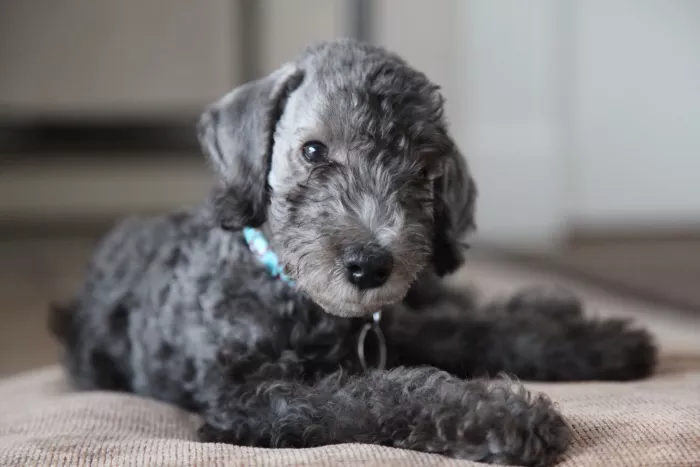The Bedlington Terrier, with its lamb-like appearance and spirited personality, is a breed that defies expectations. Often mistaken for a delicate companion due to its soft, curly coat and gentle expression, this dog has a rich history rooted in tenacity and versatility. To understand what breeds contributed to the Bedlington Terrier, we must explore its origins, genetic influences, and the roles it was bred to fulfill. This article delves into the ancestry, physical traits, and temperament of the Bedlington Terrier, revealing the surprising mix of breeds that shaped this unique dog.
The Origins of the Bedlington Terrier
Historical Background
The Bedlington Terrier originated in the 19th century in Bedlington, a mining town in Northumberland, England. Initially bred by working-class families, these dogs were prized for their ability to hunt vermin, such as rats and rabbits, in coal mines and rural landscapes. Their agility and courage also made them popular in dogfighting rings, a grim but common pastime in industrial communities.
By the mid-1800s, the breed caught the attention of aristocrats, who refined its appearance while retaining its working abilities. The establishment of the National Bedlington Terrier Club in 1877 marked a turning point, formalizing breed standards and transitioning the Bedlington from a gritty working dog to a show-stopping companion.
Ancestral Breeds in the Bedlington Terrier
The Rothbury Terrier: A Foundational Ancestor
The Bedlington Terrier’s earliest known ancestor is the Rothbury Terrier, a now-extinct breed from the Rothbury Forest region. These dogs were agile hunters, valued for their speed and endurance. Miners in Bedlington selectively bred Rothbury Terriers to enhance traits like tenacity and compact size, creating a prototype of the modern Bedlington10.
Influence of the Whippet
The Whippet, a sighthound known for its speed and slender build, played a critical role in shaping the Bedlington’s physique. Crossbreeding with Whippets introduced the breed’s distinctive arched back, deep chest, and streamlined silhouette, which allowed it to chase prey at high speeds. This hybridization also softened the Bedlington’s appearance, contributing to its “lamb-like” aesthetic.
Dandie Dinmont Terrier: Adding Texture and Temperament
The Dandie Dinmont Terrier, a small Scottish breed with a wiry coat and bold personality, contributed to the Bedlington’s unique coat texture and terrier spirit. This crossbreeding introduced the dense, lint-like fur that requires regular grooming, as well as the breed’s fearless attitude.
Otterhound and Other Water Dogs
Historical records suggest that the Otterhound, a large scent hound bred for hunting otters, may have influenced the Bedlington’s strong swimming ability and waterproof coat. This trait made the Bedlington adept at hunting water-dwelling pests, a skill highly valued in England’s river-rich regions.
Physical Characteristics: A Blend of Form and Function
The “Lamb-like” Silhouette
The Bedlington’s most striking feature is its resemblance to a sheep, achieved through selective breeding. Key traits include:
Pear-shaped head: Narrow skull with a rounded crown, tapering to a slender muzzle.
Arched back: Inherited from the Whippet, enabling swift movement.
Curly, hypoallergenic coat: A mix of soft undercoat and wiry outer fur, likely influenced by the Dandie Dinmont Terrier34.
Color Evolution
Puppies are born dark (often black or blue) and gradually lighten to shades of white, sandy, or liver as they mature. This color transformation, a genetic legacy from early terrier crosses, helped miners distinguish their dogs in dimly lit environments.
Temperament: A Paradox of Gentleness and Grit
The Terrier Spirit
Despite its refined appearance, the Bedlington retains the boldness of its terrier ancestors. It is energetic, intelligent, and occasionally stubborn, requiring consistent training to channel its high drive.
Family-Friendly Nature
Modern Bedlingtons are affectionate and loyal, thriving in active households. Their low-shedding coat and minimal odor make them ideal for urban living, though their exercise needs are substantial.
Modern Breeding and Preservation
Challenges in Genetic Diversity
Due to its niche popularity, the Bedlington Terrier faces risks of inbreeding. Responsible breeders, like those in Australia and Europe, have introduced international bloodlines (e.g., from Russia and Slovakia) to maintain genetic health and uphold breed standards.
Health Considerations
A key focus in modern breeding is preventing Copper Toxicosis, a hereditary liver disease. DNA testing, now mandatory among reputable breeders, ensures that carriers are excluded from breeding programs.
Conclusion
The Bedlington Terrier is a testament to purposeful breeding, blending the speed of the Whippet, the grit of the Rothbury Terrier, and the texture of the Dandie Dinmont. While its lamb-like charm captivates owners worldwide, its terrier heart demands respect and engagement. Understanding its ancestry not only enriches our appreciation of the breed but also guides responsible ownership and breeding practices for future generations.
Related Topics:
IS A BEDLINGTON TERRIER A GOOD FAMILY DOG?
WHEN DO BEDLINGTON TERRIERS STOP GROWING?
HOW MUCH EXERCISE DOES A BEDLINGTON TERRIER NEED?


